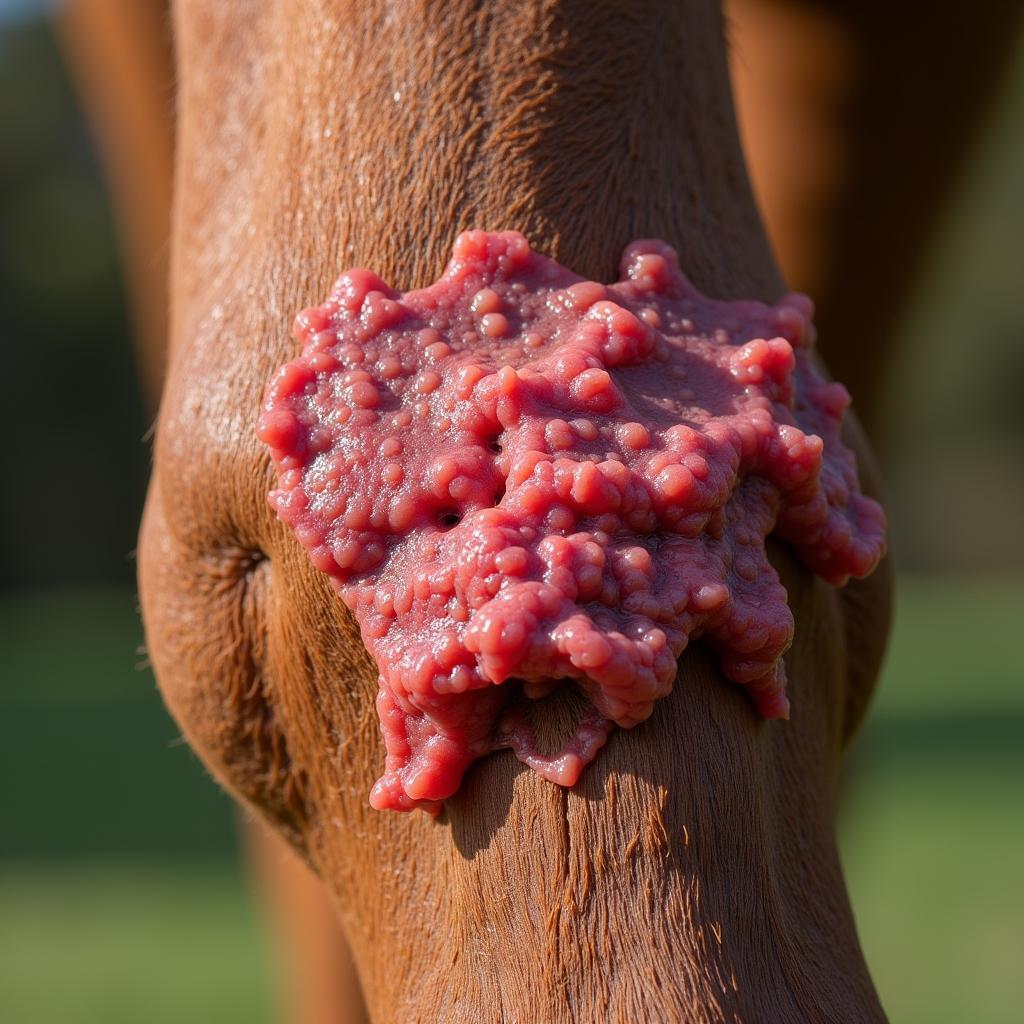Proud flesh in horses, also known as excessive granulation tissue, is a common complication of wound healing. It’s a frustrating issue that can significantly delay recovery and requires diligent Horse Proud Flesh Treatment. This article provides horse owners with a comprehensive understanding of proud flesh, its causes, and most importantly, effective treatment strategies.
Managing proud flesh can be challenging, but with the right knowledge and approach, you can help your horse heal properly. Let’s delve into the intricacies of this condition and equip you with the tools to address it effectively. We’ll cover everything from identifying proud flesh to applying various horse proud flesh treatment options. Understanding the underlying causes and the various stages of wound healing will help you choose the most suitable treatment for your horse. wound kote for horses can be an important part of your treatment plan.
What is Proud Flesh in Horses?
Proud flesh is an overgrowth of granulation tissue that protrudes above the skin surface, hindering the wound’s ability to close. It typically appears red, fleshy, and sometimes has a bumpy or granular texture. While granulation tissue is essential for wound healing, excessive growth can become problematic.
Causes of Proud Flesh
Several factors can contribute to the development of proud flesh. Locations on the lower limbs, especially below the knee or hock, are particularly prone to proud flesh due to the limited soft tissue coverage and constant movement. Excessive movement, contamination, and infection can all disrupt the delicate balance of wound healing and lead to proud flesh formation. Delay in treatment also increases the risk.
Recognizing Proud Flesh: Symptoms and Diagnosis
Identifying proud flesh is usually straightforward. The key feature is the excessive, bright red granulation tissue that rises above the surrounding skin level. The tissue may bleed easily and appear “proud” of the wound bed. If you suspect your horse has proud flesh, consulting a veterinarian is crucial for accurate diagnosis and tailored horse proud flesh treatment.
 Close-up of proud flesh on a horse's leg
Close-up of proud flesh on a horse's leg
Horse Proud Flesh Treatment Options
Various treatment options are available for managing proud flesh. The most appropriate method depends on the severity and location of the excessive tissue.
Topical Treatments
Topical medications, like corticosteroids, can help reduce inflammation and control the growth of granulation tissue. Other topical agents promote healthy tissue formation and prevent infection. Horse cream for pain can provide relief and support healing.
Surgical Removal
In some cases, surgical removal of the proud flesh may be necessary. This procedure involves carefully excising the excessive tissue and creating a clean wound bed for proper healing.
Bandaging and Compression
Proper bandaging and compression can help control swelling and minimize movement, which are key factors in preventing proud flesh. Bandaging also helps protect the wound from further contamination and trauma.
Other Treatments
Other horse proud flesh treatment options include cryotherapy (freezing the tissue) and laser therapy. These methods can be effective in reducing inflammation and promoting healthy healing.
Prevention of Proud Flesh
Preventing proud flesh is always better than treating it. Prompt and appropriate wound care is essential. Keeping the wound clean and protected from contamination, minimizing movement, and providing a supportive environment are crucial preventative measures. Regular monitoring and early intervention are key to successful wound healing and minimizing the risk of proud flesh.
What are the long-term effects of untreated proud flesh?
Untreated proud flesh can lead to chronic wounds, delayed healing, and potential complications like infection.
How can I differentiate proud flesh from healthy granulation tissue?
Healthy granulation tissue is typically pink and flat, while proud flesh is raised, red, and often bleeds easily.
When should I consult a veterinarian about proud flesh?
If you suspect your horse has proud flesh, consult a veterinarian immediately. Early intervention is crucial for effective treatment. Seeing images of proud flesh can help you identify it. You can find examples at proud flesh horse pics.
Conclusion
Horse proud flesh treatment requires a proactive and informed approach. By understanding the causes, symptoms, and available treatment options, you can help your horse heal properly and avoid long-term complications. Early intervention and consistent wound management are essential for successful recovery.
FAQs
- What is proud flesh? Proud flesh is an overgrowth of granulation tissue in a healing wound.
- Why does proud flesh occur? It is often caused by excessive movement, infection, or delayed treatment.
- How is proud flesh treated? Treatments include topical medications, surgery, bandaging, and other therapies.
- How can I prevent proud flesh? Proper wound care, minimizing movement, and prompt treatment are crucial for prevention.
- Is proud flesh painful for horses? It can be uncomfortable and potentially painful.
- How long does it take for proud flesh to heal? Healing time varies depending on the severity and treatment approach.
- What are the signs of infected proud flesh? Increased redness, swelling, pus, and a foul odor can indicate infection.
Need more help? Explore our other articles on wound care for horses. For personalized advice and assistance with your horse’s proud flesh treatment, please contact us. Phone: 0772127271, Email: [email protected] or visit us at QGM2+WX2, Vị Trung, Vị Thuỷ, Hậu Giang, Việt Nam. We have a 24/7 customer support team.